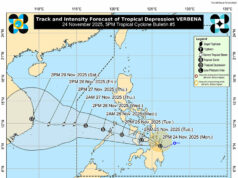Merchandise trade starts 2019 with bigger deficit — PSA data
THE COUNTRY’s trade-in-goods deficit widened in January as exports declined and imports rebounded.
Preliminary data released by the Philippine Statistics Authority (PSA) on Tuesday showed January’s trade deficit at $3.756 billion, bigger than the $3.752 billion deficit in December 2018 and $3.163 billion in January 2018.
Merchandise export sales in January amounted to $5.279 billion, 1.7% less than the $5.373 billion recorded in the same month last year.
At the same time, the country’s import bill grew by 5.8% to $9.035 billion in January from last year’s $8.536 billion.

In a statement, the National Economic and Development Authority (NEDA) noted January’s trade performance to be “largely due to a rebound in imports… supported by increases in the import values of consumer goods, capital goods, and raw materials and intermediate goods.”
EXPORTS
NEDA also noted lower foreign sales of manufactured goods and minerals that offset gains in exports of forest and total agro-based products.
Export of manufactured goods, which made up 82.9% of total sales in January, went down 2.5% to $4.375 billion from $4.488 billion in the same month in 2018.
However, electronic products bucked the trend as this grew 1.7% to $2.791 billion, with semiconductors contributing $2.037 billion, up 0.9% from $2.019 billion a year ago.
Outbound shipments of mineral products likewise declined 10.7% to $359.107 million from last year’s $402.147 million.
On the other hand, foreign sales of forest products surged by 116.3% to $24.485 million, followed by petroleum products with 60.8% growth to $46.146 million and total agro-based products with a 3.8% increase to $375.411 million.
IMPORTS
On the import side, purchases of major types of goods went up across the board except for mineral fuels, lubricant and related materials, which recorded a 9.9% decline in January to $820.543 million.
Leading growth among import categories during the month were consumer goods, which increased by 19.1% to $1.604 billion from $1.347 billion in January 2018.
Consumer goods comprised 17.8% of that month’s import bill.
Imports of raw materials and intermediate goods, which made up 39.3% of total imports, increased by 1.8% to $3.550 billion.
Capital goods, which made up 33% of the import total, grew 8.9% to $2.986 billion from $2.741 billion.
ASSESSMENT
Ruben Carlo O. Asuncion, Union Bank of the Philippines, Inc. chief economist, in an e-mail attributed mineral exports’ weakness to the fact the government “has shown hostility in the past two years” towards the mining sector.
“Although this hostility seems to be waning, there has been no issued orders that could help propel recovery and growth of the said sector,” he said.
Furthermore, Mr. Asuncion ascribed the decline of manufactured goods exports to “weak perception” on the prospects of further trade, particularly in Asia, as well as the “inherent economic slowdown in major economies.”
“We know that China is one of the country’s major trading partners and it is the same China that is currently involved in trade issues with the United States,” Mr. Asuncion said.
ING Bank N.V. Manila senior economist Nicholas Antonio T. Mapa said in a note that growth of consumer goods imports showed consumption “remains vibrant.”
However, he said capital formation “may have reached its peak” given slower growth of raw materials and capital goods.
UnionBank’s Mr. Asuncion expects weakness of the country’s exports to persist this year, even as “there is upside on the potential resolution of the US-China trade conflict through a possible trade agreement between the world’s largest economies…”
“Imports, on the other hand, are expected to continue to grow as inflation slows further and domestic consumption recovers. Furthermore, the continuing infrastructure development push will also continue to drive imports higher,” he added.
ING’s Mr. Mapa said that imports may continue to grow this year though “at a more subdued pace.”
“Elevated borrowing costs may have been hampering some of the capital expansion although, given the prospects for the economy, corporates and the government remain bullish with capital outlay plans announced,” Mr. Mapa said.
On the export side, Mr. Mapa hopes for a turnaround in exports this year given the growth in raw material imports needed for electronic products.
“With raw materials used for electronic exports growing by 5.1%, this could mean that exporters are building up on work in process and raw material inventory for a possible rebound in 2019 despite the US-China trade spat,” he said.
“However… the Philippine export sector will need to continue to build on sector-changing reforms to help boost productivity by enhancing supply chains and increasing standards. With the government’s ‘Build, Build, Build’ initiative seen to help boost efficiencies, perhaps the export sector can take advantage of this push and we can see the export renaissance that we’ve all been waiting for.”
Meanwhile, NEDA expects imports growth to be “constrained” given the delayed approval of the 2019 budget and the 45-day public works ban ahead of the May 13 midterm elections.
“The importation of raw materials is likely to be affected by the holdback in the implementation of numerous projects under government’s ‘Build, Build, Build’ program,” NEDA quoted its director-general, Socioeconomic Planning Secretary Ernesto M. Pernia, as saying.
Japan was the Philippines’ top export market for the month with a 16.8% share at $884.95 million, followed by the United States’ 15.8% share at $833.87 million and Hong Kong’s 12.2% share at $645.17 million.
In terms of imports, China was the Philippines’ top source of foreign goods with a 22.2% share of the total at $2.01 billion, followed by South Korea’s 8.7% share at $789.56 million and Japan’s 8.7% share at $789 million. — Lourdes O. Pilar



